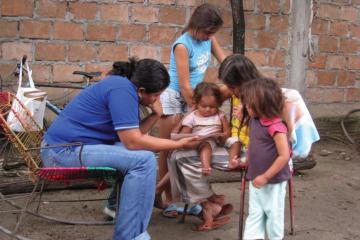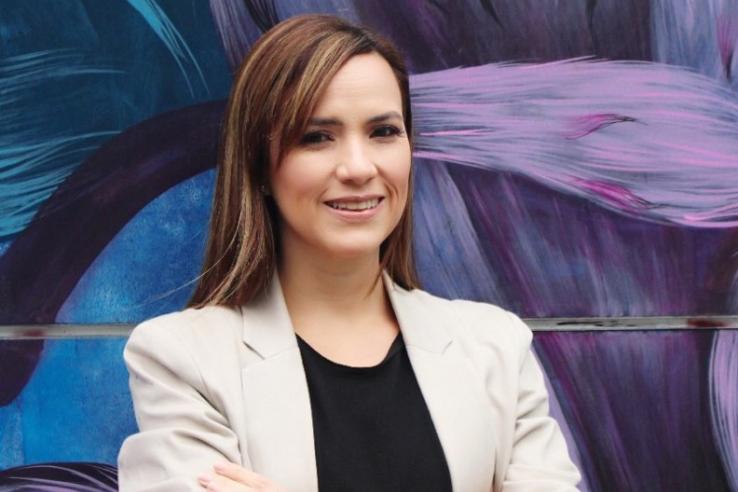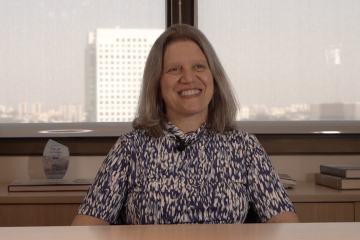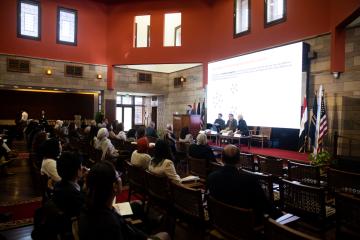
Scaling an early childhood program in Peru: Lessons from an alliance between Aporta, IPA, and J-PAL LAC

In 2017, Innovations for Poverty Action (IPA) Peru and J-PAL Latin America and the Caribbean (J-PAL LAC) began a collaboration with the Peruvian civil association Aporta—the social impact platform of Breca, a conglomerate of Peruvian companies. The main goal was to promote the use of data and evidence in the early childhood development (ECD) program the organization had been designing.
During these years, we accompanied the organization in designing and adjusting programs based on evidence. One remarkable result of the collaboration is the scaling of the Volar program, which seeks to cost-effectively promote ECD and to strengthen caregivers’ capacities through digital platforms. Thanks to funding from the Development Innovation Ventures (DIV) of the United States Agency for International Development (USAID), Volar is being piloted with caregivers from Peru’s National Cuna Más Program.
We spoke with Fabiola Cáceres, Manager of Innovation and Social Impact at Aporta, who explained how the partnership with J-PAL and IPA was vital to bring together key actors such as the Peruvian government, private organizations, academia, and international cooperation for ECD in Peru and achieving success.
How did the collaboration between Aporta, IPA Perú, and J-PAL LAC come about to promote evidence of what works in ECD?
One of Aporta's guiding principles is to deploy social impact projects based on evidence and show their results to make decisions about which programs should be expanded. Along these lines, it was natural to look for a strategic ally like J-PAL and IPA to work together to develop a deep understanding of the problem we were trying to solve and devise and pilot alternative solutions, generating evidence that would allow us to validate the potential impact and learn during the process.
Could you describe the importance of the partnership for the recent expansion of the Volar program at the national level?
The partnership has been central in all stages of the project. Initially, it helped us understand the problem from international child development evidence. It also helped us identify promising cost-effective and scalable programs.
During the testing and learning phase, it was crucial to measure and gain knowledge about which prototypes had the most potential impact and viability for scaling. As a result, we were able to refine the model and concentrate our efforts and resources on the most cost-effective technology-based components.
The academic network of J-PAL and IPA was also fundamental because we were able to interact with them and get their feedback during the process. This provided us access to experts with experience in ECD and the use of internationally validated measurement schemes and instruments on the subject. Thanks to this, since its conception, the program has been rigorously measured and refined. This has given a lot of credibility to the program, not only at the level of the rigor of the work and the ambitious commitment to ECD but also credibility at the level of the results that we could present to make internal and external expansion decisions.
Finally, we have been allies in applying for and obtaining important funds granted by USAID for the rigorous testing of interventions that have the potential to solve complex global challenges. This has allowed us to test the impact of Volar at the national level. In particular, we were then able to generate rigorous evidence of the additional impact of adding technology-based interventions to the work with child caregivers that Cuna Más already carries out. We will now be able to know what happens when these technology-based interventions are incorporated into policy and it allows us to dream of multiplying the reach of Volar not only in Peru but also in other countries.
What are the next steps after having obtained funding from DIV and signed an agreement with the Peruvian government to scale the pilot nationally?
Now that we are in the process of implementing the pilot, we will have full support from IPA and J-PAL to carry out the rigorous measurement. We hope that if the intervention has an impact, a public policy can incorporate these interventions into its operational model and permanently and organically impact more children. Our ideal goal is that, if this works, it can inspire similar policies in different places because we believe that it is a solution that has consistently proven to be effective, low cost, and have the potential to improve parenting environments for the comprehensive development of boys and girls.
What lessons could this collaboration give to other early childhood interventions?
Those of us who work on social projects are sometimes very focused on the challenges of implementation but it is essential not to lose sight of the strategic part. That is, ask ourselves why we are doing what we are doing and be very clear about the logical value chain and the intermediate and final results we want to achieve. There, the support of IPA and J-PAL is central because, once you are clear about the results you want to achieve and the theory of change behind the intervention, you can build indicators and a monitoring and evaluation plan—and then see the progress and learn as you go. But above all, we learn to generate knowledge, and show that the investment of resources we are making makes sense.
Furthermore, this type of technical support makes us stronger not only in implementation but also in terms of the partnerships that we have and that we should want to have. Many times we can leverage resources in limited spaces, and it is through public policy and partnerships with third parties that we can multiply the impact. However, to open these doors, the support of researchers is central as it allows us to show independent objective results as well as the rigor with which development projects are implemented. I believe that when you have allies like J-PAL and IPA, you can achieve those goals. And I feel that the power of having the private sector, the public sector, academia, and civil society at the table can enhance the impact and achieve interventions that not only help move the needle in the face of multiple social challenges but also shows that collective action is possible and that the sum of efforts multiplies the possibilities of obtaining concrete results and advancing the development agenda more decisively.
The post-pandemic world and the deterioration of development indicators force us to think differently and do things differently, looking to multi-actor collective action to achieve different results. I believe that Aporta's coordinated work with IPA and J-PAL is a clear example of how, by bringing the right actors to the table and seeking synergies, processes are accelerated, collaboration and efficiencies are generated and, above all, the set objectives are achieved.
Related Content

Encouraging early childhood stimulation from parents and caregivers to improve child development

20 for 20: Vivianne Naigeborin on the evolution of JOI Brazil and promoting productive inclusion


